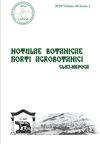Deciphering the myth of cold tolerance in soybean: An overview of molecular breeding applications
IF 1.3
4区 生物学
Q3 PLANT SCIENCES
引用次数: 0
Abstract
The soybean is a source of several dietary components, including milk, protein, and oil. Cold stress has significantly curtailed soybean growth and yield in large areas and caused a high risk to global food security. The main objective of soybean breeders is to improve soybean resistance to cold stress. Conventional breeding approaches have made significant progress in developing cold tolerance in soybean; however, the high cost and complex genetic mechanism of cold tolerance hindered the large scale of these techniques. Molecular tools like quantitative trait loci (QTL), genome-wide association studies (GWAS), transcription factors (TFs), genetic engineering, and transcriptome have been used to identify cold tolerant genes/QTL and to develop soybean cultivars tolerant to cold stress. Clustered, regularly interspaced short palindromic repeats (CRISPR/Cas9) is used to increase the abiotic stress tolerance in soybean; however, its use to edit the cold tolerance genes in soybean is limited. Mapping of QTL has accelerated the master-assisted selection (MAS) in soybean. This review presents a detailed overview of molecular techniques and their use in developing cold-tolerant soybean cultivars. Using CRISPR/Cas9 would increase the speed of molecular breeding for cold tolerance in soybean. This information will assist soybean researchers in uncovering the basis of cold stress tolerance in soybean and adopting the most suitable way to breed the cold tolerant cultivars which can thrive under the extreme pressure of cold stress.解读大豆抗寒性的神话——分子育种应用综述
大豆是几种膳食成分的来源,包括牛奶、蛋白质和油。寒冷胁迫严重影响了大豆的大面积生长和产量,给全球粮食安全带来了高风险。大豆育种者的主要目标是提高大豆的抗寒性。传统育种方法在大豆抗寒性方面取得了重大进展;然而,高成本和复杂的耐寒遗传机制阻碍了这些技术的大规模推广。数量性状位点(QTL)、全基因组关联研究(GWAS)、转录因子(TFs)、基因工程和转录组等分子工具已被用于鉴定耐冷基因/QTL和培育耐冷大豆品种。聚集的、有规则间隔的短回文重复序列(CRISPR/Cas9)被用于提高大豆的非生物胁迫耐受性;然而,它在大豆耐冷基因编辑中的应用是有限的。QTL的定位加速了大豆的主辅助选择(MAS)。本文综述了分子技术及其在大豆耐寒品种选育中的应用。利用CRISPR/Cas9技术可以加快大豆耐冷性分子育种的速度。这些信息将有助于大豆研究人员揭示大豆耐冷胁迫的基础,并采取最适合的方式培育在极端冷胁迫下茁壮成长的耐冷品种。
本文章由计算机程序翻译,如有差异,请以英文原文为准。
求助全文
约1分钟内获得全文
求助全文
来源期刊

Notulae Botanicae Horti Agrobotanici Cluj-napoca
PLANT SCIENCES-
CiteScore
2.70
自引率
0.00%
发文量
118
审稿时长
3 months
期刊介绍:
Notulae Botanicae Horti Agrobotanici Cluj-Napoca is a peer-reviewed biannual journal aimed at disseminating significant research and original papers, critical reviews and short reviews. The subjects refer on plant biodiversity, genetics and plant breeding, development of new methodologies that can be of interest to a wide audience of plant scientists in all areas of plant biology, agriculture, horticulture and forestry. The journal encourages authors to frame their research questions and discuss their results in terms of the major questions of plant sciences, thereby maximizing the impact and value of their research, and thus in favor of spreading their studies outcome. The papers must be of potential interest to a significant number of scientists and, if specific to a local situation, must be relevant to a wide body of knowledge in life sciences. Articles should make a significant contribution to the advancement of knowledge or toward a better understanding of existing biological and agricultural concepts. An international Editorial Board advises the journal. The total content of the journal may be used for educational, non-profit purposes without regard to copyright. The distribution of the material is encouraged with the condition that the authors and the source (Notulae Botanicae Horti Agrobotanici Cluj-Napoca or JCR abbrev. title Not Bot Horti Agrobo) are mentioned.
 求助内容:
求助内容: 应助结果提醒方式:
应助结果提醒方式:


